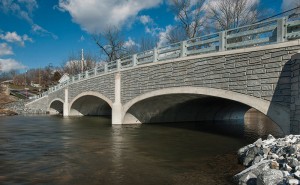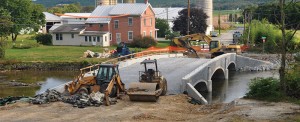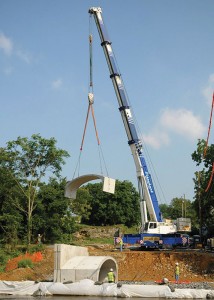The Burnt House Road Bridge, a historic bridge set in the countryside of rural central Pennsylvania, was in need of an update – and it needed it quickly. After being closed to traffic in 2009 following an underwater inspection that revealed undermining of the foundations, the Pennsylvania Department of Transportation (PennDOT) needed a solution that would quickly bring the bridge back into operation for the nearly 2,100 cars that cross the bridge on a daily basis.
Constructed in 1912, the bridge carries Burnt House Road over the Yellow Breeches Creek in Dickinson Township – about 30 miles outside of Harrisburg, PA. At nearly 100 years old, the single-lane bridge already had a posted load limit of only three tons, which was not conducive for normal traffic – let alone nearby quarry traffic.
After the 2009 closure, Dickinson Township, which owns Burnt House Road, and PennDOT, the bridge’s owner, embarked on an evaluation process to determine if the original bridge could be rehabilitated or if it would need to be replaced altogether. Bridge engineering firm Modjeski and Masters was engaged for preliminary and final design, and faced the challenge of balancing the community’s preference to preserve the appearance of the original “humpback” bridge with modern day traffic demands.
Context Sensitive Design Calms Community Concerns
Because of the community’s attachment to the visual aesthetic of the original bridge, context sensitive solutions were an important design consideration. These solutions needed to not only preserve the look of the original bridge, but also to improve bridge functionality and safety for pedestrian and vehicular traffic.
The replacement bridge design is composed of a wider bridge that now accommodates two lanes of vehicle traffic with a sidewalk that facilitates safer pedestrian traffic. A new sidewalk was incorporated on the same side of the road as nearby Stuart Park – an added safety feature for park visitors and Yellow Breeches Creek fishermen alike.
The new, three-barrel arch structure chosen for the replacement bridge serves a dual purpose. First, the center barrel is raised relative to the outer barrels, which maintains the humped profile that was important to the community. Second, the large opening of the center barrel improves hydraulic functionality by better accommodating stream flow and preventing an increase in backwater, which in turn reduces the risks of flooding nearby properties.
Finally, the new bridge’s stone facade was created to replicate the look of regional limestone used in the construction of nearby historic structures. Arch headwalls were fabricated using stacked stone pattern formliners to give the appearance of stone. The concrete was then stained to mimic the regional grey limestone.
Accelerated Construction Reduces Environmental Impact
Other improvements were incorporated into the designs to streamline construction, improve traffic flow and decrease future maintenance. Because Burnt House Road is a primary travel route through Cumberland County, and the bridge was already closed to traffic, getting a new bridge back into operation as quickly as possible was important to PennDOT and Dickinson Township officials. Accelerated construction alternatives were evaluated, and the final designs incorporated 30-ft. pre-cast CON/SPAN arch units to streamline construction time.
The Yellow Breeches Creek is deemed a high-quality, stocked and naturally producing trout stream. The Pennsylvania Fish and Boat Commission regulates in-stream construction to prevent disruptions to trout reproduction. As such, in-stream construction activities between March 1 – June 15, and October 1 – December 31 are prohibited. Because the available window for construction time is limited by these regulations, the use of prefabricated arch units drastically reduced the amount of time construction teams needed in-stream access.
Asphalt Deck Streamlines Future Maintenance
Another benefit to the use of CON/SPAN units was the ability to incorporate an asphalt deck versus a reinforced concrete deck. Bridge redecking typically occurs every twenty to thirty years, and can be a lengthy process with a substantial price tag and can often require substantial bridge closures. Repaving saves future costs associated with ongoing bridge maintenance, reduces traveler headaches and improves bridge longevity. Further, PennDOT’s ultimate goal is to transfer ownership of the new bridge to Dickinson Township, so future maintenance and its impact on the local taxpayer was an important consideration.
Improved Alignment and Traffic Flow
To facilitate better traffic flow across the bridge, the project also involved modifications to the horizontal alignment of Burnt House Road. Prior to the bridge replacement project, the road had a distinct “kink” immediately prior to the bridge on the south side. The design team incorporated a new alignment that eliminated the kink, enabling traffic to flow more freely across the bridge.
One of the major challenges the design team faced when creating a new alignment was working within the given right of way. Because of historic structures nearby, including a stone farmhouse, ruins from a stone barn and nearby wetlands – all of which were important historic and aesthetic components of the bridge setting – the new alignment would need to be created in a way that avoided any impacts on these elements.
Gilbert Cornwell, former Dickinson Township resident of more than fourteen years, believes he speaks for local residents when he says he is “very pleased” with the new bridge. “I have heard people talking who wanted the bridge to be shut down completely, and now they say it’s a very nice bridge. We are very pleased with the new bridge.” Township manager, Laura Portillo commented that “the beauty of the bridge speaks volumes” and added that many residents comment on how great it looks; that it kept the feel of the old bridge.
The Burnt House Road Bridge replacement project served a critical need in Dickinson Township, PA. Closed to traffic because of its current condition, the township needed a new bridge that maintained the same aesthetic qualities – quickly. Modjeski and Masters incorporated design features such as prefabricated CON/SPAN arches to streamline construction, while at the same time focusing on context sensitive design solutions to maintain a similar bridge profile and appearance to best compliment its natural setting. The new Burnt House Road Bridge will ultimately save taxpayer dollars by reducing the amount of future maintenance, while helping to prevent future lengthy bridge closures due to redecking.▪
Project Team Members
Owner: PennDOT District 8 (Justin Gochenauer – Project Manager), Harrisburg, PA
Contractor: Hempt Brothers, Inc. Camp Hill, PA
Fabricators: CONTECH Engineered Solutions, LLC, West Chester, OH & Terre Hill Concrete Products, Terre Hill, PA



